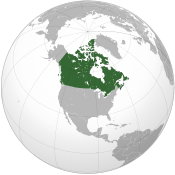Canada, U.S. to tighten security between 'cross-border' library
Sunday, May 27, 2007
The Royal Canadian Mounted Police (RCMP), the United States Border Patrol and local officials from both sides are looking into tightening security at a Quebec library. The library has been deliberately on the border of Canada and the U.S. since it was built in 1904 by American sawmill owner Carlos Haskell and Canadian wife Martha Stewart Haskell for availability to both countries.

At Haskell Free Library and Opera House, in Rock Island, Quebec, a black line diagonally runs across the center of the library to mark the international border. Ironically the line puts the seats in the U.S. and the opera stage in Canada.
Both towns share the same water supply, sewer systems and emergency crews thus they cross the border without going against the law. In total, there are three streets that cross the border and there are cameras on both sides to monitor illegal activity, but that doesn't tighten border security enough officials say.
"There's been an increase in illegal activity, both north and south, in the last little while," said operations officer for the Border Patrol's Swanton sector, Mark Henry."There have been some significant cases. This all fits in to the larger picture of the Border Patrol strategy to gain operational control of our borders."
"I don't think they're aiming at people who go pick up groceries and come back. It's people that want to use this in a bad way," says Cpl. Luc Bessette, a spokesman for the RCMP.
To enter the U.S. at Haskell Free Library and Opera House, in Rock Island, Quebec, all one needs is directions to go to Stanstead, Quebec, directions to the local library and walk through the doors; they have illegally entered Derby Line, Vermont, U.S. If one walks across from Stanstead St. to Derby Line they will be at the checkout in the U.S., go to the library from Derby Line to Stanstead St. and they have officially entered back into Canada. The international border also is on Canusa St., a residential street in Stanstead, Quebec and Beebe Plain, Vermont.
If someone wants to see their neighbour across the street, they would be re-entering the U.S. Anyone who comes from Stanstead St. to Derby Line, to visit their neighbour, must report to Customs or they could be sent to jail for illegally entering. However, residents do not need to notify Customs if they cross the border inside buildings.
Currently, the front door is in Vermont and if Quebecers couldn't enter the front they would have to go through the back way. If Americans wanted to park in the parking lot they couldn't because it is legally in Canada.
A meeting will take place this 19 June at 7 p.m. local time asking whether residents want to prevent people from crossing the border regularly or, in some cases, illegal crossings. During a meeting last Thursday in Stanstead, Quebec, local officials from both countries (towns) said border walls and fences will not be put up due to local residents' concerns. They say there are other alternatives.
There is also a movement to separate Vermont from the U.S. or to make it the 11th province of Canada, with three territories. The website "Vermont Canada" says the state should join Canada due to its remaining liberal policies as opposed to the U.S.
Sources
[edit]- Wilson Ring - Associated Press. "Border with Canada runs through library in Vermont village" — CBC News, May 26, 2007
- Wilson Ring - Associated Press. "Derby Line security called into question" — Montreal Gazette, May 26, 2007
- "Smugglers Cross U.S. Border Through Library" — INDYchannel, May 26, 2007
- Robin Smith. "It's Up To Local Communities To Decide, Official Say" — Caledonian Record, May 26, 2007
External links
[edit]- Unrelated



